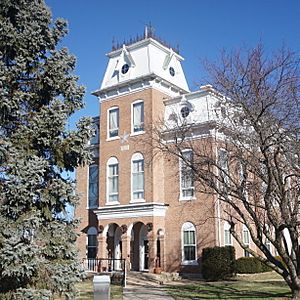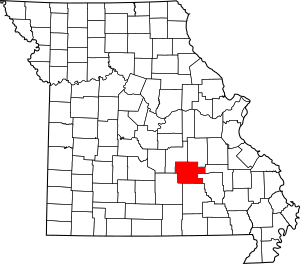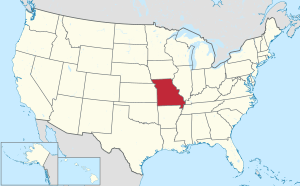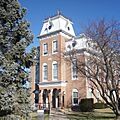Dent County, Missouri facts for kids
Quick facts for kids
Dent County
|
|
|---|---|

Dent County Courthouse in Salem
|
|

Location within the U.S. state of Missouri
|
|
 Missouri's location within the U.S. |
|
| Country | |
| State | |
| Founded | February 10, 1851 |
| Named for | Lewis Dent, a pioneer settler |
| Seat | Salem |
| Largest city | Salem |
| Area | |
| • Total | 755 sq mi (1,960 km2) |
| • Land | 753 sq mi (1,950 km2) |
| • Water | 1.7 sq mi (4 km2) 0.2% |
| Population
(2020)
|
|
| • Total | 14,421 |
| • Density | 19.101/sq mi (7.375/km2) |
| Time zone | UTC−6 (Central) |
| • Summer (DST) | UTC−5 (CDT) |
| Congressional district | 8th |
Dent County is a county located in the state of Missouri. In 2020, about 14,421 people lived here. The biggest city and the main government center is Salem.
The county was officially started on February 10, 1851. It was named after Lewis Dent. He was an early settler and a state representative who came to Missouri from Virginia in 1835.
Contents
History of Dent County
Early Explorers and Settlers
One of the first people to explore the area that is now Dent County was Henry Rowe Schoolcraft. This was back in 1818, when the land was mostly unknown. Schoolcraft and his friend Levi Pettibone went on a long adventure. They often faced hunger and danger.
They traveled through what is now southern Dent and Shannon counties. Schoolcraft found the Current River, which he described as "a fine stream with fertile banks and clear, sparkling water.” Today, many people enjoy canoeing on the Current and Jack's Fork Rivers. These rivers are part of the Ozark National Scenic Riverways.
Long before white settlers arrived, Native Americans used trails in Dent County. One important path was part of the Trail of Tears. This was a difficult journey for many Cherokees who were forced to move to Oklahoma. Some Cherokee families stopped and settled in Dent County. Many local families are proud of their Cherokee heritage.
The first white settler was George Cole. He started a farm near the Meramec River. Other early settlers arrived around 1829. They mostly settled near the Meramec, Spring Creek, and Dry Fork valleys. Some of these first families included William Thornton, Daniel Troutman, and Lewis Dent.
How Dent County Was Formed
In 1851, the Missouri Assembly decided to create Dent County. It was made from parts of Crawford, Shannon, and Texas counties. The county was named after Lewis Dent, who was also its first representative.
The first county officials were G.D. Breckenridge, Samuel Hyer, Jr., and Jotham Clark. Joseph Millsap was the first sheriff, and David Henderson was the first clerk. They held their first meetings at the Bressie Farm.
The first mayor of Salem was W.P. Williams, also known as "Rip." He became mayor in 1860. City governments were stopped during the American Civil War. After the war, other mayors included O.A. Kenemore and E.T. Wingo.
The Dent County Courthouse
The first courthouse in Dent County was a log building. It was built around 1851 or 1852. Later, in 1852-53, a new courthouse was built. It was about 20 by 40 feet. This building was unfortunately burned during the Civil War.
Another courthouse was built in 1864, but it also burned down in 1866. The beautiful Victorian-style courthouse that stands today was built in 1870. It cost $15,500 to build. A.E. Dye was the main builder, and his son E.L. Dye helped him. This courthouse is now listed in the National Register of Historic Places.
Electricity and Telephones Arrive
In 1909, 23 people worked together to bring electric lights to Salem. They formed the Salem Light & Power Co. Later, the city took over the electric system.
Mrs. Thomas A. Bruce started the first telephone system around 1900. Charlie Jeffries helped her install it. Homes paid $1 per month for telephone service, and stores paid $1.25. The telephone system was later sold to United Telephone, which is now Sprint.
Dent County's Industries
For a while, Salem was a world leader in making and shipping railroad ties. The area has always had a lot of timber. Wood from Dent County was used for barrels, flooring, and charcoal. The Bunker-Cul1er Lumber Co. was one of the biggest lumber businesses.
Dent County faced economic challenges, like during the Great Depression. However, all five of its banks managed to stay open. During the Great Depression, the Civilian Conservation Corps (CCC) brought young men to the area. They helped build roads and improve the land. For example, in the Indian Trail Conservation Area, CCC crews built most of the 55 miles of access roads.
After World War II, needlework factories became important. Ely & Walker's factory was one of the first. Other factories like International Shoe Factory and Salem Sportswear followed. Today, many of these local needlework industries have closed due to competition.
After World War II, Dent County saw many changes. In 1950, there were 60 one-room schools. Over time, these combined into fewer, larger school districts. Roads were improved, and the Salem Memorial District Hospital was built.
Modern Economy
Today, the largest employer in Dent County is U.S. Foodservice. This company provides food to businesses and institutions. It started in Salem as Craig Distributing after World War II. The Craig family has given back to Salem by helping create places like Craig Plaza and the Alice Lou Craig Municipal Swimming Pool.
Dent County was once known as the "Feeder Pig & Calf Capitol of Missouri." Farmers would sell large numbers of livestock at big auctions. However, these sales have ended as fewer people are farming.
Geography
Dent County covers about 755 square miles. Most of this area is land, with only a small part being water.
Neighboring Counties
- Crawford County (to the northeast)
- Iron County (to the southeast)
- Reynolds County (to the southeast)
- Shannon County (to the south)
- Texas County (to the southwest)
- Phelps County (to the northwest)
Protected Natural Areas
- Mark Twain National Forest (part of it is in Dent County)
- Ozark National Scenic Riverways (part of it is in Dent County)
Population Information
| Historical population | |||
|---|---|---|---|
| Census | Pop. | %± | |
| 1860 | 5,654 | — | |
| 1870 | 6,357 | 12.4% | |
| 1880 | 10,646 | 67.5% | |
| 1890 | 12,149 | 14.1% | |
| 1900 | 12,986 | 6.9% | |
| 1910 | 13,245 | 2.0% | |
| 1920 | 12,318 | −7.0% | |
| 1930 | 10,974 | −10.9% | |
| 1940 | 11,763 | 7.2% | |
| 1950 | 10,936 | −7.0% | |
| 1960 | 10,445 | −4.5% | |
| 1970 | 11,457 | 9.7% | |
| 1980 | 14,517 | 26.7% | |
| 1990 | 13,702 | −5.6% | |
| 2000 | 14,927 | 8.9% | |
| 2010 | 15,657 | 4.9% | |
| 2020 | 14,421 | −7.9% | |
| U.S. Decennial Census 1790-1960 1900-1990 1990-2000 2010-2015 |
|||
In 2000, there were about 14,927 people living in Dent County. There were nearly 6,000 households. About 30% of households had children under 18. The average household had 2.45 people.
The median age in the county was 40 years old. About 25% of the population was under 18.
| Race | Num. | Perc. |
|---|---|---|
| White (NH) | 13,203 | 91.6% |
| Black or African American (NH) | 52 | 0.36% |
| Native American (NH) | 61 | 0.42% |
| Asian (NH) | 54 | 0.37% |
| Pacific Islander (NH) | 7 | 0.05% |
| Other/Mixed (NH) | 773 | 5.4% |
| Hispanic or Latino | 271 | 1.9% |
Religion in Dent County
Most people in Dent County who follow a religion are evangelical Protestants. The largest groups are Southern Baptists, Pentecostals, and Roman Catholics.
Getting Around Dent County
Main Roads
Airport
- Salem Memorial Airport
Education
In Dent County, about 66% of adults aged 25 and older have a high school diploma or higher. About 10% have a bachelor's degree or higher.
Public Schools
- Dent-Phelps R-III School District - Salem
- Green Forest R-II School District - Salem
- Green Forest Elementary School (Grades K-8)
- North Wood R-IV School District - Salem
- North Wood Elementary School (Grades PK-8)
- Oak Hill R-I School District - Salem
- Oak Hill Elementary School (Grades PK-8)
- Dent-Phelps Elementary School (Grades K-8)
- Salem R-80 School District - Salem
- William H. Lynch Elementary School (Grades K-2)
- Salem Upper Elementary School (Grades 3-6)
- Salem Jr. High School (Grades 7-9)
- Salem High School (Grades 10-12)
Special Schools
- Salem 61 School - Salem - (Grades K-12) - For special education students.
- Ozark Hills State School - Salem - (Grades K-12) - For students with special needs.
Colleges
- Southwest Baptist University Annex - Salem - A smaller campus of Southwest Baptist University.
Public Library
- Salem Public Library
Towns and Communities
Cities
Unincorporated Communities
Images for kids
See also
 In Spanish: Condado de Dent para niños
In Spanish: Condado de Dent para niños


